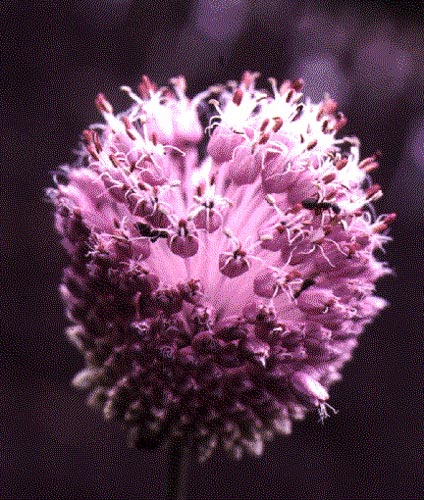Relatives
Allium vineale L. - Crow garlic
Taxonomic position.
Family Alliaceae J.Agardh, genus Allium L.Morphology and biology.
Herbaceous perennial bulbous plant. Bulb is ovoid, with grey-brown papery outer tunics, more or less torn. Small alternate bulbils are yellowish, glossy, smooth. Stem is 40-80 cm high. Leaves, 4-5 in number, are fistular, semicylindrical, grooved, smooth, significantly shorter than the stem. Umbel is hemispheric, oliganthous. Numerous small bulbils develop between separate flowers of the inflorescence; there are individual plants with inflorescences consisting of only bulbils or only flowers. Pedicels are several times longer than the perianth. Tepals are pink or purple with a darker vein, 3-4.5 mm in length; outer tepals are oblong, carinate, slightly broader than the inversely lanceolate inner ones. Filaments are a little or almost 1.5 times longer than the tepals; they are accrete at the base, slightly ciliate. Style expressly protrudes from the perianth. Blossoms from mid-June till late August. Entomophilous.Distribution.
Widespread in Europe, in the southern provinces of the European part of Russia, in the Caucasus (Eastern and Southern Transcaucasia), and Asia Minor.Ecology.
Grows in the areas with moderate and warm climate. In the European sector of its area of distribution this species initially grew on rocky slopes and steppizated environments within phytocoenoses where fescue and brome were dominating as well as in oakeries and brushwood; only later it penetrated forsaken plots, gardens and orchards getting accustomed to the secondary environment. Regarded nowadays as weedy, this species most often occurs in vineyards and gardens, and prefers alkaline substrates. Despite good adaptability of crow garlic, its growth habit is strongly affected in a negative way by mechanized soil cultivation and application of various chemical fertilizers.Utilization and economic value.
For food (vegetable) and as a source of vitamins. Useful qualities of this species have been poorly explored.References:
Vvedensky, A.I. 1935. Onion - Allium L. (Flora of the USSR, vol. IV.) Leningrad: Publishing House of the USSR Academy of Sciences, p.237. (in Russian).Grossgeim, A.A. 1940. Flora of the Caucasus, vol.2. Bakhu ***** p.117.(in Russian).
Randushka, D., Shomshak, L. and Gaberova, I. 1990. Colour atlas of plants. Bratislava: Obzor Publishers, pp.213-214. (in Russian).


